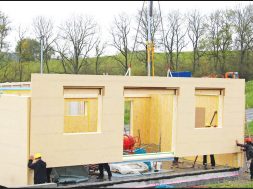Modern airports with a blend of functionality and aesthetics

The leading experts across the architectural industry have shared their expertise about intelligent material use and strategic integration of natural elements to embrace sustainability and adaptive reuse that delve into the layers of innovation shaping the airports of the future.
In the ever-evolving landscape of airport design, architects are navigating a dynamic canvas marked by the pursuit of versatility, sustainability, and a seamless passenger experience. Ar. Srilata Ramkumar, IAP Director at E&A Design Consultants LLP, sheds light on a pivotal design aspect of value. Creativity became the cornerstone in the wake of global disruptions like the COVID-19 pandemic, where airports faced unprecedented challenges. Srilata emphasises that the overarching goal is to maximise value beyond materials, form, or function. The COVID-induced standstill saw a surge in demand for freight and merchandise, challenging architects to reimagine terminal designs with resilience and adaptability.
Ar. Komal Kotwal, Founder and principal Consultant of EquiSustain, delves into the heartbeat of airport design and passenger experience. In a world where airports are judged by the speed and joy with which passengers move from point A to point B, any glitch in this journey can damage an airport’s reputation. The ripple effect of a negative experience travels far, as word of mouth becomes a potent force shaping perceptions. For Komal, the passenger experience is not just a checkbox; it’s the linchpin that can make or break an airport’s standing in the eyes of travellers.
Efficient space use and layout design take centre stage in the narrative of Vishwajit Pandey, Country Head of Business Development at Xpereos Stones. Pandey emphasises that a successful airport design must balance utility, sustainability, and passenger experience. Functionality is paramount, with layouts meticulously crafted to optimise the movement of people and luggage within the aircraft. Sustainability, a key pillar in modern design, manifests in well-planned layouts that seamlessly incorporate eco-friendly concepts. Pandey highlights the ripple effect: a thoughtfully designed airport translates into comfortable waiting areas and strategically positioned amenities, enhancing the entire passenger journey.
Ar. Chanchal Poddar, head of the design studio at DFI, emphasises cultural identity and place-making as indispensable elements in terminal design. According to Chanchal, terminals serve as the entrances to a city, making it imperative to showcase the culture and essence of the place. In the tapestry of terminal buildings, efficiency emerges as the linchpin considered the most significant feature in terminal design. The fusion of efficiency and cultural representation becomes the guiding principle for architects shaping a city’s first impression through its airport.
Furthermore, Srilata introduces a nuanced perspective, weaving a story around the diverse requirements of airlines. Terminals catering to low-cost airlines (LCC) typically follow a segregated model. Within the standard terminal, premium lanes exist for business class or premium passengers, offering a distinct experience. Architects must ingeniously fill the gaps to amalgamate these varied needs under one shelter. However, in stringent cost considerations, a separate low-cost terminal emerges, ensuring a clear separation between airlines and passengers. This procedural approach seeks to harmonise the diverse demands of different airline categories.
Chanchal sheds light on the imperative role of passive design strategies in enhancing energy efficiency in airport terminals across India. Incorporating shading devices like roof overhangs and skylights further contributes to thermal comfort. Green roofs and thoughtful interior space design emerge as integral elements in conserving energy and upholding aesthetic and functional considerations in the overall design of airport terminals.
Komal delves into the growing trend of environmentally conscious frameworks in upcoming airports. While not mandatory, many airports are opting for certifications such as IGBC. Examples such as Bangalore International Airport boasting a LEED Platinum terminal and the LEED certification of the Indira Gandhi International Airport highlight the commitment to sustainable practices. Additionally, the emergence of the PEER certification certification system, witnessed in airports like Bangalore, addresses power system performance and electricity infrastructure challenges. This trend underscores a collective effort towards sustainable practices, offering solutions for the ageing infrastructure in the aviation sector.
The choice of materials plays a pivotal role in achieving harmony between aesthetics, sustainability, and functionality. Komal stresses the need for a nuanced approach to the use of glass, rejecting a simplistic, more-or-less quantity mindset. Instead, she advocates for intelligent usage, emphasising the benefits of double-skin facades in diverse Indian climates. Architects and engineers, she insists, should scrutinise glass placement intelligently, considering factors such as heat gain. An illustrative project exemplifies this approach, countering heat concerns on the west facade with a cost-efficient canopy and shading. Technology-driven modelling is a key tool for making informed and sustainable design decisions.
Srilata further deepens the discourse, asserting that airport design in India should prioritise intelligent material use beyond merely reducing glass. Advanced simulations enable pre-construction assessments of local materials like mud or straw, considering cost and energy efficiency. Integrating technology into design decisions, Srilata contends, ensures sustainability, meeting energy efficiency goals for airport operators while preserving visual connectivity for stress reduction and passenger comfort.
As Vishwajit highlighted, the strategic integration of natural stones in modern airport designs adds another layer to the narrative. Beyond enhancing aesthetic appeal, using locally sourced stones aligns with sustainability goals, reducing carbon footprints and fostering a unique, culturally rich experience for passengers.
Srilata introduces the concept of adaptive reuse and circular design principles, a global practice in airport architecture that aims to extend the lifespan of structures and minimise the need for new constructions. This approach transforms unused terminals into functional spaces, optimising the initial capital investment. From master planning to execution, this strategy aligns with management strategies, ensuring every structure serves a purpose, emphasising sustainability, and minimising waste in airport infrastructure’s overall design and lifecycle.
Komal’s insights into daylighting strategies reveal an approach tailored to specific terminal areas. From waiting zones to check-in counters and corridors, each space demands a unique strategy. Top lit daylighting solar elements benefit larger spaces, while counters and corridors can optimise natural light through sunshades. Integrating simulation software during conceptual design is crucial, allowing architects to analyse daylight impact, identify potential glare issues, and ensure sufficient natural light in all areas.
60
Cookie Consent
We use cookies to personalize your experience. By continuing to visit this website you agree to our Terms & Conditions, Privacy Policy and Cookie Policy.










